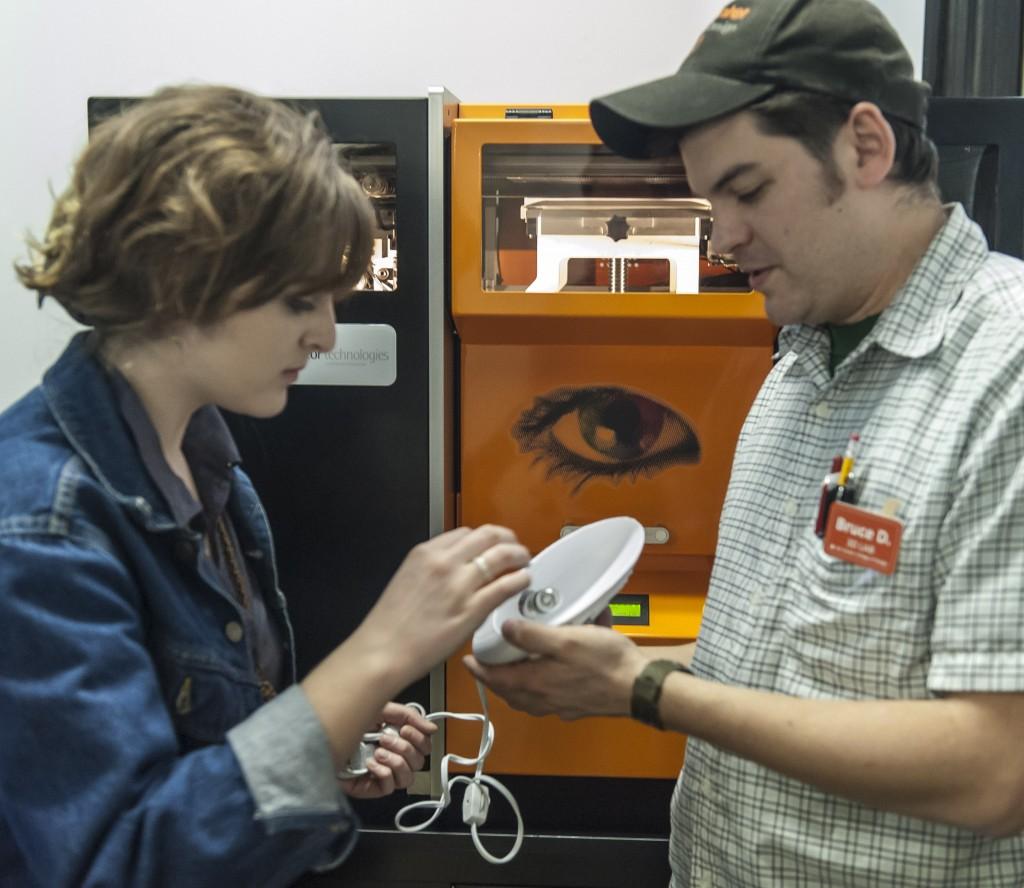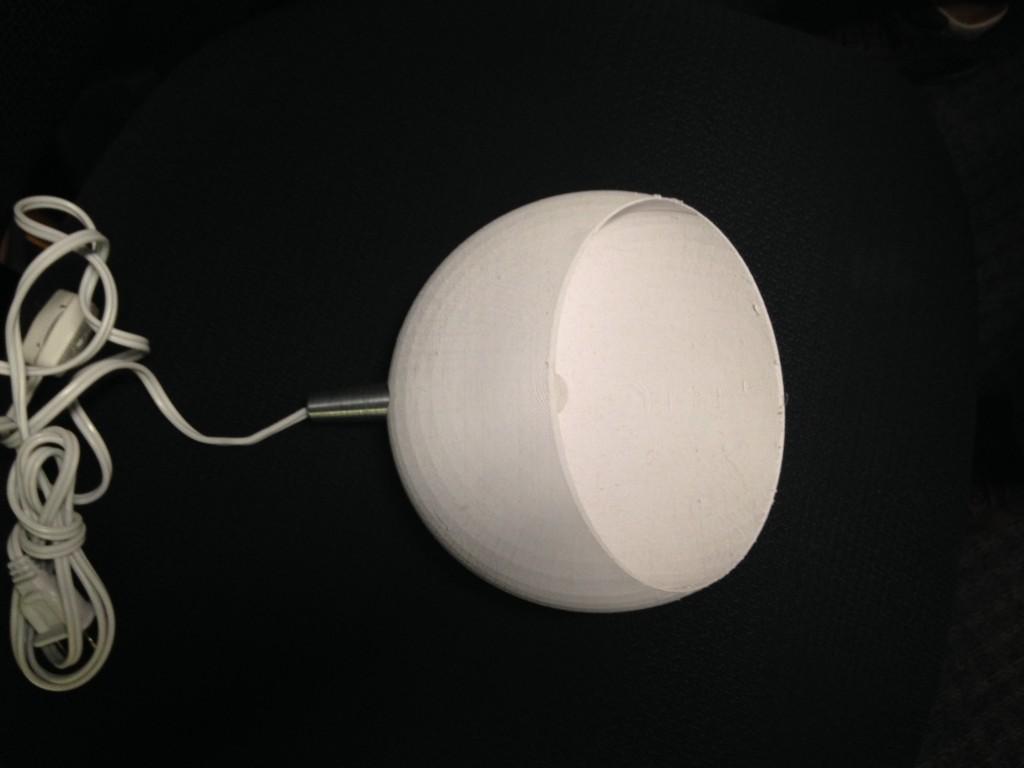Pasadena’s Art Center College of Design’s New Mcor IRIS 3D Printer Excels in Case Study of Affordability & Quality
 The future of technology just keeps arriving in waves, one after the other, continually improving and offering different benefits — layer after layer — just like the magic of 3D printing itself.
The future of technology just keeps arriving in waves, one after the other, continually improving and offering different benefits — layer after layer — just like the magic of 3D printing itself.
The Mcor IRIS is one such wave of the future in 3D printing as the material to feed into this machine is so wonderfully available — and cheap. It’s the perfect 3D printer for an educational setting, where budget is always a concern. And while paper is generally a budget concern as well at school, the costs for everyday copy/printer paper as 3D printing material are certainly significantly less than those for traditional plastic filament.
In a setting where college students are expected to pay for their own 3D printing costs, the situation could get pretty severe money-wise. If you remember the days of scraping together loose change to go out on the weekend and struggling to pay rent or buy gas for what was probably your first car, then you are well aware that a college student’s allotted budget for 3D printing is pretty slim, no matter how brilliant, innovative, and motivated they are.
The motto at Art Center College of Design in Pasadena, CA is “Learn to create. Influence Change.” And while they are consumed with creating, they are also thoughtful about the process and what it takes to do so.  Because of that, the college added something new to their collection of twelve 3D printers: an Mcor IRIS 3D printer. They wanted to see if it could indeed enrich the experience of 3D printing for their students, and in performing a case study to assess it in terms of affordability, quality, environmental-friendliness, and added innovation, they were more than pleased. And an outpouring of 3D printed models has been the result.
Because of that, the college added something new to their collection of twelve 3D printers: an Mcor IRIS 3D printer. They wanted to see if it could indeed enrich the experience of 3D printing for their students, and in performing a case study to assess it in terms of affordability, quality, environmental-friendliness, and added innovation, they were more than pleased. And an outpouring of 3D printed models has been the result.
While students are very involved and engaged in the 3D printing process at this learning institution with a strong focus on art and design, they are required to pay for their own 3D printing expenses. Students have access to a wide variety of tools at the college as there are a number of different specific disciplines covered like product design, transportation design, fine arts, environmental design, and more. With access to contemporary resources needed to produce innovative artwork and designs, students are able to use the “fleet of 3D printers” available in multiple locations, but it became apparent that material costs could be prohibitive for the typical student budget.
With the addition of the new 3D printer, they are able to see an enormous savings. Mcor, a company we’ve enjoyed reporting on often, is well aware what a good match the 3D printers are for students and has courted the educational sector with enticing discounts and programs. With basic paper as a material, costs are cut to a fraction of the price.
“In addition to low operating cost and unmatched color, the green factor was a tremendous boost for the Mcor IRIS,” says Cawley. “It’s very green. In fact, we’ve put it in an office space because, unlike most 3D printers, it doesn’t spew dust or fumes. In addition, models can be recycled along with ordinary paper because they essentially are paper.”
Diversity in tools is an important facet at the school, however, and while the IRIS is certainly forging ahead with a list of benefits that greatly benefit the students, they try to offer equipment that can fit a number of different unique requirements depending on the project.
“3D printing is definitely on the rise across all disciplines,” says David Cawley, director of rapid prototyping and model shops, “whether making car models, props for photography classes, characters for animation, fine art, or furniture.”
The IRIS opens up a vast world in terms of options with the capability to print in whatever pattern a color printer is capable of working with, as well as the enormity of offering one million colors to print with due to the Color Consortium map — offering incredibly high resolution and comprehensive reliability.
“The Mcor IRIS has extended our toolbox in so many ways,” says Cawley. “What makes it unique is a super low operating cost. Since the build material is ordinary paper, students can make, for example, custom rims and tires for a one-fifth scale car at $2 per cubic inch instead of the $6 it would cost with a plaster-based machine or the $20 it would cost with ABS plastic. That price differential makes a world of difference to students who want to try out more, perhaps bolder ideas than they could otherwise afford.”
“And when a student is making a model that should resemble a metallic painted finish, Mcor models – which are essentially reconstructed wood – are easier to sand, drill, prime and paint,” says Cawley. “This quality is just another way Mcor opens up new creative possibilities to Art Center students.”
 Students have gone to town using the IRIS for a number of new and exciting projects from building busts to automotive components to other innovative prototypes. Cawley points out that their projects have ‘come out beautifully,’ including a batch of avant-garde lamps.
Students have gone to town using the IRIS for a number of new and exciting projects from building busts to automotive components to other innovative prototypes. Cawley points out that their projects have ‘come out beautifully,’ including a batch of avant-garde lamps.
Obviously the wide range of vibrant color available, coupled with the material and affordability, is making the IRIS popular, but still, faculty encourage and remind students to use the appropriate tools for each job, and with so much to choose from, that often means choosing the correct 3D printer. Choosing the correct technology and the right 3D printer, regardless of price, has become a challenge worldwide on a general basis as well, as there are so many different 3D printers now available offering so many unique features and opportunities to print with a multitude of materials from paper to chocolate to glass and metal — and far more.
“Students shouldn’t be putting all their eggs in one basket. They should be synthesizing what they know about each device’s strengths,” said Cawley. “The Mcor IRIS’s strengths include its affordability, greenness and color capabilities. It’s serving us well in product design, transportation design and fine arts, and we’re only scratching the surface of its potential.”
The addition of the IRIS showed the college that indeed, they were able to produce 3D prints at a fraction (one-third to one-tenth) of the price, be environmentally friendly with the ability to recycle materials and discarded projects, enjoy a fume-free atmosphere, and go crazy printing with a wide array of colors. That’s certainly a success story for the new purchase.
With nearly 2,000 students studying for careers in art and design, only time will tell if they have enough 3D printers as the technology gains in popularity and continues to progress. Do you attend a school or university that has 3D printers on campus? Do you have to pay for materials, and if so, how does that affect your ability to create with 3D printing? Tell us your thoughts in the Art Center College of Design’s New ISIS 3D Printer forum over at 3DPB.com.
Mcor Technologies has headquarters in Ireland, the UK, and the US. We’ve reported on them often regarding expansion and a variety of programs. Founded by the MacCormack brothers in 2004, they aim to offer innovative, affordable 3D printing tools that will allow everyone to enjoy the technology.

Subscribe to Our Email Newsletter
Stay up-to-date on all the latest news from the 3D printing industry and receive information and offers from third party vendors.
You May Also Like
Precision at the Microscale: UK Researchers Advance Medical Devices with BMF’s 3D Printing Tech
University of Nottingham researchers are using Boston Micro Fabrication‘s (BMF) 3D printing technology to develop medical devices that improve compatibility with human tissue. Funded by a UK grant, this project...
3D Printing Webinar and Event Roundup: April 21, 2024
It’s another busy week of webinars and events, starting with Hannover Messe in Germany and continuing with Metalcasting Congress, Chinaplas, TechBlick’s Innovation Festival, and more. Stratasys continues its advanced training...
3D Printing Webinar and Event Roundup: March 17, 2024
It’s another busy week of webinars and events, including SALMED 2024 and AM Forum in Berlin. Stratasys continues its in-person training and is offering two webinars, ASTM is holding a...
3D Printed Micro Antenna is 15% Smaller and 6X Lighter
Horizon Microtechnologies has achieved success in creating a high-frequency D-Band horn antenna through micro 3D printing. However, this achievement did not rely solely on 3D printing; it involved a combination...






























